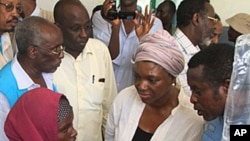The United Nations humanitarian chief has visited Somalia's capital where tens of thousands of people are in desperate need of food and medical assistance.
Valerie Amos visited a hospital Saturday during her tour of Mogadishu and met with people who have fled their homes in southern Somalia in hopes of escaping the famine. Amos said the sight of malnourished, emaciated children in the hospital was deeply distressing.
She said it is crucial to help these children and their families however they can, though security remains difficult.
The U.N. is scaling up its aid efforts in Mogadishu, since the al-Qaida-linked al-Shabab militant group began withdrawing from the city.
Al-Shabab once controlled nearly all of Mogadishu and still controls large swaths of central and southern Somalia. The group has tightly controlled the delivery of aid to famine victims and has banned access for many international aid agencies.
The African Union, which maintains a peacekeeping force in Somalia, said Saturday it had discovered a large cache of weapons left behind by the withdrawing militants.
An AU spokesman said troops found and destroyed 137 artillery shells in a Mogadishu neighborhood formerly controlled by the militants. The spokesman said they believe the shells were stockpiled to make bombs.
The famine was, in part, sparked by a devastating drought that is affecting the entire Horn of Africa region.
The U.N. says thousands of Somalis have already died from the effects of the drought. The crisis has forced hundreds of thousands of Somalis to trek long distances to find help in crowded camps in Mogadishu, and in neighboring Kenya and Ethiopia.
Most of the famine zones are controlled by al-Shabab militants.
Some information for this report was provided by AP, AFP and Reuters.









